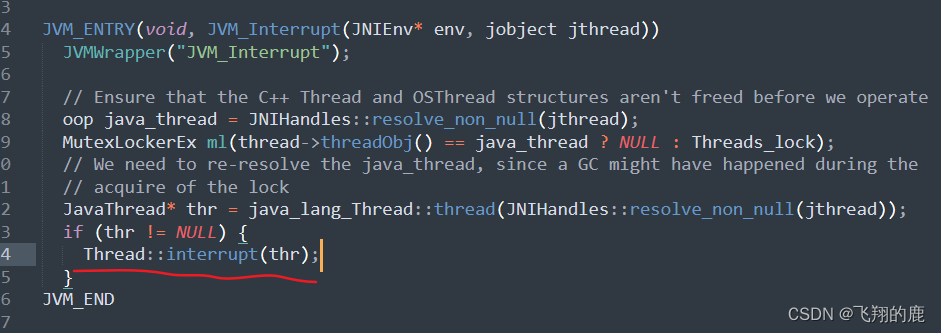众所周知,interrupt是线程中断相关的方法,那么interrupt在底层又究竟干了什么呢?
本章内容要探究的问题:
1.interrupt究竟做了什么?
2.interrupt真的中断了线程吗?
3.isInterrupted与interrupted有什么区别?
好了,接下来进入源码...
一、interrupt
调用interrupt方法,可以看到,除了检查当前线程和自定义扩展线程中断情况外,就直接调用了interrupt0方法,该方法是native的。
在c++中,调用的是jvm.cpp的JVM_Interrupt方法;(图1-1)
紧接着调用的线程的interrupt方法。(图1-2)

(图1-1)

(图1-2)
重点来了...
在interrupt方法中,做了两件事情 (图1-3):
1.设置线程中断状态为true;
2.唤醒线程;
在唤醒线程时,有多种情况:如果线程正在sleep状态时;如果线程是调用unsafe.park方法时;如果线程是在synchronized代码块中调用wait时,都将唤醒该线程。

(图1-3)
至此,interrupt方法结束;在源码中,interrupt方法设置了中断状态,然后唤醒线程;
与其说是中断线程,不如说是中断线程所处的状态,让其回归正常,比如线程处于sleep/wait/park状态,将其唤醒。
二、isInterrupted与interrupted
isInterrupted方法,最终调用的是isInterrupted(booloean clearInterrupter)方法,传参为false;
interrupted方法,最终调用的是isInterrupted(booloean clearInterrupter)方法,传参为true;
两个方法只是参数不同而已 (图2-1)...
isInterrupte后的isInterrupted为native方法,接下来又到快乐的从c++世界了...
在c++中,对应的是jvm.cpp的JVM_IsInterrupted方法,

(图2-1)
进入其中,在方法中最终又调用了线程的is_interrupted方法,并把java的参数代入其中(图2-2);

(图2-2)
重点逻辑:
在此方法中(图2-3),获取到线程的中断状态,然后 判断是否为已中断(中断标记为true),并且是否清除为true(就是java传入的参数),如果满足条件,则清除中断标记,设置为false,最后返回之前查询的中断状态;由此可知,isInterrupted与interrupted都是获取线程的中断状态,区别在于interrupted获取到为中断状态之后,会清除中断状态!

(图2-3)
回到本章开头的提问:
1.interrupt究竟做了什么?做了两件事情1.设置线程中断标记为true,然后唤醒线程。
2.interrupt真的中断了线程吗?没有做中断线程的事情,而是唤醒线程!
3.isInterrupted与interrupted有什么区别?都是获取线程的中断状态,而interrupted获取之后会清除线程中断状态。
最后,附上本人的测试用例:
测试1:放开注释1,主线程死循环打印日志,每次休眠一秒,t1线程设置主线程中断;结果:主线程执行结束,休眠状态被中断,抛出线程中断异常,可在catch中捕获异常。
测试2:放开注释2,主线程先进行park挂起,t1线程设置主线程中断;结果:主线程被唤醒继续执行,打印输入日志。
测试3:放开注释3,主线程调用wait进行挂起,t1线程设置主线程中断;结果:主线程执行结束,挂起状态被中断,线程抛出中断异常,可在catch中捕获。
测试4:放开注释4,先让t1线程设置主线程中断,分别调用isInterrupted和interrupted方法;结果:isInterrupted查询线程状态,interrupted查询线程状态并清除了线程状态。
/**
* @author : ZPF
* @date : 2022-06-21 09:51:57
* @description : 测试线程的Interrupt方法
* 在jvm源码中,interrupt做了两件事情:
* 1.设置中断标记为true
* 2.唤醒线程unpark(唤醒Thread.sleep/Unsafe.park/synchronized())
* <p>
* Thread.currentThread().isInterrupt() 方法:查询线程是否为中断状态
* Thread.interrupted() 方法:查询线程是否为中断状态 并还原 还原为false
*/
public class TestInterrupt {
private final static Object OBJ = new Object();
public static void main(String[] args) {
Thread mainThread = Thread.currentThread();
Thread t1 = new Thread(new Runnable() {
@Override
public void run() {
System.out.println("t1 thread start...");
try {
Thread.sleep(3000);
} catch (InterruptedException e) {
e.printStackTrace();
}
mainThread.interrupt();//设置为中断状态 唤醒线程
System.out.println("t1 thread end...");
}
}, "t1");
t1.start();
//1.sleep方法会触发唤醒线程
// while (true) {
// try {
// Thread.sleep(1000);
// } catch (InterruptedException e) {//抛出中断异常 当线程在sleep时调用interrupt 抛出
// e.printStackTrace();
// System.out.println("catch InterruptedException...");
// break;
// }
// System.out.println("main thread running...");
// }
//2.unsafe.park方法会触发唤醒线程
// Unsafe unSafe = getUnSafe();
// System.out.println("main thread running start...");
// unSafe.park(false, 0L);
// System.out.println("main thread running end...");
//synchronized中会触发唤醒线程
// synchronized (OBJ) {
// System.out.println("main thread wait start...");
// try {
// OBJ.wait();
// } catch (InterruptedException e) {//抛出中断异常 当线程在wait时调用interrupt 抛出
// e.printStackTrace();
// System.out.println("catch InterruptedException...");
// }
// System.out.println("main thread wait end...");
// }
//4.isInterrupted与interrupted区别
// sleep(4000);
// boolean interrupted = mainThread.isInterrupted();//查询线程中断状态
// System.out.println("main interrupted1: " + interrupted); //true
// interrupted = mainThread.isInterrupted();
// System.out.println("main interrupted2: " + interrupted); //true
//
// interrupted = Thread.interrupted(); //查询线程中断状态 并还原 还原为false
// System.out.println("main interrupted3: " + interrupted); //true
// interrupted = Thread.interrupted();
// System.out.println("main interrupted4: " + interrupted); //false
}
/**
* 自定义休眠方法
*
* @param timeOut
*/
public static void sleep(long timeOut) {
long start = timeOut + System.currentTimeMillis();
long end;
do {
end = System.currentTimeMillis();
} while (end <= start);
}
public static Unsafe getUnSafe() {
Field field = null;
try {
field = Unsafe.class.getDeclaredField("theUnsafe");
field.setAccessible(true);
return (Unsafe) field.get(null);
} catch (Exception e) {
e.printStackTrace();
}
return null;
}
}最后的问题?
1.为什么要有中断状态?
当线程调用interrupt方法时,设置中断状态,可中断线程的sleep/wait/park状态,程序员可以获取中断状态进行业务逻辑操作。
2.线程的其他方法
这些问题将在后续文章中解答...感谢各位的阅读。





















 349
349











 被折叠的 条评论
为什么被折叠?
被折叠的 条评论
为什么被折叠?








